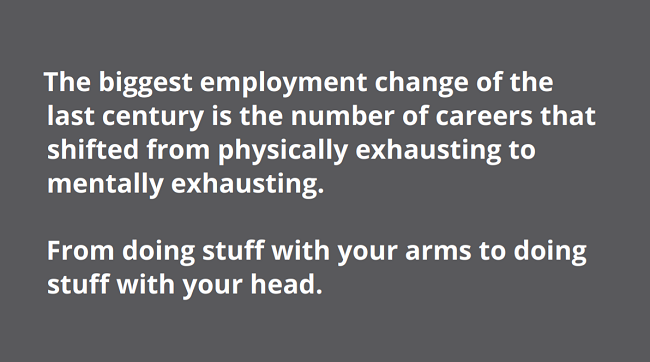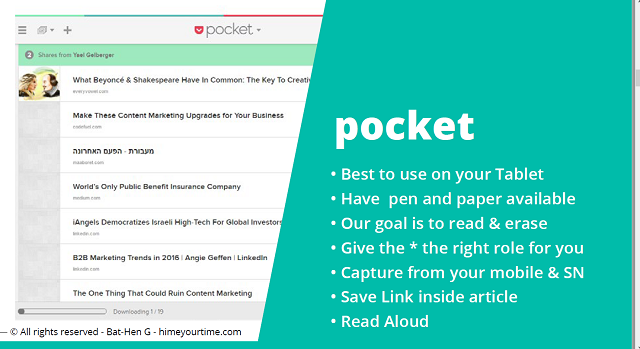Do you use “Pocket” or “Evernote” or any similar content capturing tool?
Pocket, Evernote and other content capturing tools allow you to read online content even when you’re not online.
They also allow you to use Zen read so you can quickly scan the content without any banners, ads or menus that distract your eyes,
If you’re like most of the world population, you may have accidentally turned Pocket into a “digital content graveyard.” No ghosts or headstones, mind you, but stacks and stacks of content you will never find time to read.
1. Identify your HIME for reading digital content
HIME = High Impact, Minimum Effort.
The HIME for any given activity is the time during the day/week when you personally can accomplish that task using the least amount of energy but achieving the greatest results.
In this particular case, you’re trying to figure out when scanning through your Pocket will be relatively easy as compared to other times in the week.
My personal HIME for my Pocket reading is usually Thursday afternoons.
I won’t necessarily empty it every week; I find that my pace is about once a month. Yet it shows up in my calendar every week to remind me of this task.
Whether or not I accomplish it, I will always push that calendar reminder forward for next week/month, so this important task always stays on my mind.
2. Set the right environment for digital reading
- I like to sit out on my balcony, or another place with a relaxed atmosphere (to read articles out of Pocket you don’t need WiFi, so you have more flexibility in the setting you choose).
- I’ll read out of my tablet on an iPad screen so I have good resolution but no distractions or temptations to check up on emails or social media (I avoided installing email and social media on my iPad to begin with).
- I’ll also pour myself a drink – so my brain wires the activity as FUN and will help me repeat it whenever I need.
- I have a pen and notebook beside me to write down ideas, quotes or names I want to follow up on.
Under these environmental conditions I can now start – and in one concrete hour I scan an average of 50 articles (!).
That’s a lot for only 1 hour, so you can understand how important setting the environment is for the efficiency of this task.
When I go on a walk, I’ll take my mobile with Pocket to listen to videos.
3. Don’t hoard articles
If you haven’t emptied your Pocket in a month, stop saving new items.
By stopping collection you are effectively “punishing” yourself for not putting in the time to read everything.
It will also drive you crazy that you cannot save more… and these consequences should be somewhat motivating enough to seek a focused 1-2 hours to go in and scan and clean your Pocket.
Just remember: these hours need to be on your HIME.
It should feel fairly easy and fun to do the reading, otherwise you will not succeed in making this a long-term habit.
4. Limit yourself to only 3 tags
Why only three?
Because, among many reasons, capturing should be quick and easy. Additionally, it is easier to scan all the content you saved when you don’t have to think too much about which tag you’re clearing now.
Personally, I use the “Videos” tag for videos or podcasts because listening to videos or podcasts is an easy way to consume content when I’m walking, driving or folding the laundry.
The “Videos” tag enables me to quickly sort out these pieces of content whenever I’m about to do one of those “body-busy, mind-free” activities.
This leaves me with two tags to use as I desire.
You can even use less than three tags, but, if you like tagging, try very hard to limit yourself to three.
5. Go easy on the eyes
Pocket is amazingly flexible when it comes to the visual settings, enabling you to change the background color, font and size.
Here are two ways I set Pocket to go easy on my eyes:
- I read my Pocket material in large fonts, so I don’t need my glasses.
- I also read white font over a dark grey background, which again is easy on the eyes and helps me scan a large number of articles per hour.

By using a tablet to do the reading:
- I can hover over hyperlinks and have them saved without opening them (genius feature), lessening potential eye-catching distractions.
- By avoiding my laptop, I’m also staying away from other distractions, like notifications or emails I might be tempted to answer.
- Folding the laundry? Your Pocket can read articles aloud.
6. Add the task “Pocket” to your calendar
If it isn’t written down, it isn’t happening.
Add “Pocket” to your calendar at the time you’ve decided is your digital reading HIME.
Whether you did it or not, at the end of the day, manually move that task forward by a week, or two weeks, or a month, to the next time you think would be a good time to scan and empty your Pocket.
WARNING: I recommend that you do not use the “Recurrence” feature in your calendar.
There is something concrete about manually moving the invite, because we tend to ignore things that happen automatically.
I find that I end up sitting down once or twice a month to skim Pocket. The calendar invite, however, is on my radar every week. It shows up, makes me aware of its presence, and I then push and postpone it as needed.
We tend to overestimate what we can do in a week and underestimate what we can achieve in a year.
Remembering this fact helps us postpone and procrastinate on our tasks as needed.
7. Connect Pocket to other tools
I use IFTTT to connect Pocket with other webtools, making it even more efficient and fun.
I try to write important ideas, names and quotes in my notebook and then delete the article, but sometimes I need the entire piece back in my inbox to share it with others.
So I added a recipe from IFTTT that says “Send Favorite Articles To Inbox.”
Whenever I click on the * key, the article is automatically sent to my inbox. I then delete the article from Pocket, since the full article is waiting in my inbox for further use.
Another recipe I did with IFTTT is “Every Liked Item on YouTube, Save to Pocket.” That way, when I hit a video that I want to watch, I can quickly add it to Pocket and move on with my life.
Don’t go overboard with adding too many recipes and automated processes.
One or two are more than enough.
When it comes to webtools, my rule of thumb is not “the more, the merrier.”
Quite the opposite.
8. Look at the author’s name before you start scanning the article
Often we find that the content pieces we captured are not as interesting as we thought they’d be.
The “clickbait” headline didn’t deliver what it promised or the writer’s style just isn’t right for us.
In today’s information era, there’s too much information as it is.
Protect your precious time and headspace by becoming super critical and cautious of what you keep letting in to your system.
Take note of who the author or source is before you start to scan any given article, so that over time you can change and improve your sources.
9. Capture content from social media
On most social media, you can use the Share button to capture content and send it to Pocket.
Facebook is the one exception to that rule.
Since FB doesn’t allow sharing to external devices, you have to first open the content on your mobile browser and hit “share to Pocket” from the browser itself.
Because I work closely with a capturing tool, I can commit to a 20 minute scroll of my social media every morning. Anything I want to scan and read will be sent to Pocket, so in these 20 minutes I can concentrate on engaging with friends and followers.
The reading and researching work will wait for a better time and day.
There is one exception to this rule: if it is urgent or critical to read today or this week, I will send it to my inbox, as I only get to my Pocket once or twice a month.








